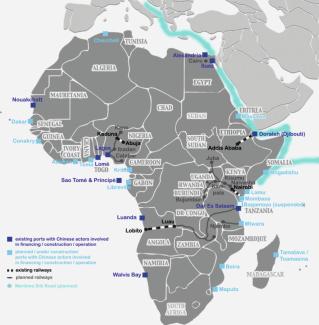Chinese foreign policy
Silk road across the Indian Ocean

China’s One Belt One Road initiative (OBOR) was launched in 2013. It is designed to improve trade infrastructure beyond China’s borders in Asia and Europe. It is often overlooked, however, that OBOR also involves projects in Africa. In regard to major investments there, Julia Breuer of Ruhr-University Bochum suggests it would be more accurate to speak of “two” belts.
Hotspots of Chinese infrastructure development in East Africa are Djibouti, Egypt, Ethiopia, Tanzania, Zambia and Angola. In May 2017, the 472 kilometre standard gauge railway (SGR) link between the Indian Ocean port of Mombasa and Kenya’s capital Nairobi opened. It was largely financed with Chinese money. According to Breuer’s study, Chinese-built railway links are gradually forming a network throughout East Africa.
In Djibouti, for instance, the Chinese helped to finance the construction of the port of Doraleh and made sure it was connected by railway to the important neighbour and trading partner Ethiopia – a landlocked country. A pipeline was built as well. Both Doraleh port and the 730 kilometre long railway to Addis Ababa became operational this year, according to Breuer’s study, which was recently published by Stiftung Asienhaus, a non-governmental German think tank.
There are further plans to link Addis Ababa to Kenya’s SGR. That would make rail transport to South Sudan, Uganda, Rwanda and Burundi possible, as Breuer writes.
Furthermore, China wants to revitalise the 1,900 kilometre long Tanzania-Zambia Railway which was built with Chinese help in the 1970s. Among other things, it served to transport Zambian copper to the port of Dar es Salaam. In the future, this railway is to be connected to the Lobito-Luau railway, which became operational in 2015 and links the Angolan coast to the border of the Democratic Republic of the Congo. The shores of the Indian and Atlantic Oceans will thus be connected by railway.
In addition, a railway link from landlocked Zambia via Malawi to Mozambique is under construction. Memorandums of understanding between the government of Chad and Chinese companies signed last year suggest that Chad might become an important east-west nexus as well.
Connecting the hinterland
In West Africa, Chinese investments focus on Nigeria and Togo, providing funding for the ports of Lagos and Lomé respectively. Near Lagos, Lekki deep sea port is under construction. Moreover, Chinese companies are contributing to the expansion of inner-Nigerian railway routes.
By connecting the ports with the inland provinces, China is making sure that products and resources can be transported to the coast and then exported to China. Even more important, Africa is a crucial market for China’s exports. As Breuer points out, moreover, Chinese-owned companies are producing ever more goods in Africa. Garment manufacturing in Ethiopia is an example. Accordingly, the Ethiopia-Djibouti railway serves essential trade needs.
In most cases, African governments welcome Chinese engagement. In contrast to western governments, the one in Beijing claims to adhere to the principle of non-interference in other countries’ politics and does not discuss issues of governance. Its approach to development partnerships is “rather trade than aid”, writes Breuer.
Africa’s people seem to appreciate Chinese infrastructure projects as well. In an Afrobarometer survey of 36 African countries, almost two-thirds of respondents said China’s influence was positive in their country, while only 15 % saw it as negative. According to Breuer, China’s infrastructure, development and business investments are seen as reasons for the country’s positive image in Africa.
Links
Breuer, J., 2017: Two Belts, One Road? The role of Africa in China’s Belt & Road Initiative. Blickwechsel, Stiftung Asienhaus.
https://www.asienhaus.de/uploads/tx_news/Blickwechsel_OBOR-Afrika_01.pdf
Afrobarometer Round 6, 2016: China’s growing presence in Africa wins largely positive popular reviews.
http://afrobarometer.org/sites/default/files/publications/Dispatches/ab_r6_dispatchno122_perceptions_of_china_in_africa1.pdf








